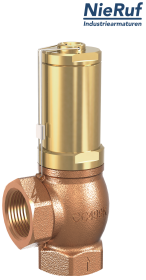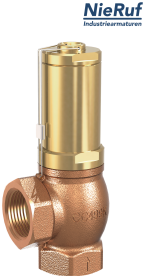What is an overflow valve?
The purpose of an overflow valve is to safeguard pumps or other pressurised systems. As the name suggests, the valve is "overflown" when a certain pressure level is reached, and then opens to discharge the pressurised medium.
How does an overflow valve work?
The valve houses a spring or gaiter which offers less force than the oncoming medium when pressure increases beyond the set value, thus opening the valve once the set response pressure is reached. In the next stage, the valve opens in line with the pressure increase, thereby dissipating power. Once the Required Overflow Volume is reached, the lift adjusts automatically. When the pressure drops again, the valve closes gradually until it is completely shut when falling below the response pressure
How to install an overflow valve?
In a first step, the entire plant must be rinsed so that the valve cannot become clogged by soiling. Be sure to provide appropriate safeguards if the installation site puts persons and the environment at risk due to a release of medium. Most bypass valves can be installed in any position without compromising their function. However, when fitting them, be sure not to drive the internal thread too deep by using force, as this may damage the valve seat. Also, it must be ensured that sealing materials such as Teflon or hemp cannot get into the valve, as this may compromise tightness. In many cases, these valves are installed downstream of a pump to discharge any impermissible overpressure.
How to set an overflow valve
Depending on the design variant, the valve is set using an Allen key, a hand wheel or other tools suitable for turning. Turning it clockwise will increase the pressure (response pressure), while turning it anticlockwise will decrease the pressure (response pressure). Most overflow valves can be set under service conditions; however, this naturally requires a pressure measurement (e.g., manometer) to be made upstream of the bypass valve. As an alternative, the valve can be factory-set to the desired pressure.
Does an overflow valve require maintenance?
Most overflow valves are maintenance free, although a valve of course requires servicing when the plant itself suffers a malfunction. If pressure increases are not reliably discharged any more, this may suggest that the valve is defective and will have to be replaced. If the system pressure won't built up to the desired working pressure, this may suggest a leaky valve seat, in which case the valve may have to be replaced, too.














 Contact
Contact  Resistance check
Resistance check  Frequently asked questions
Frequently asked questions  Configurator
Configurator